Dive Training Blogs
Deptherapy returns to its Roots – Part 3
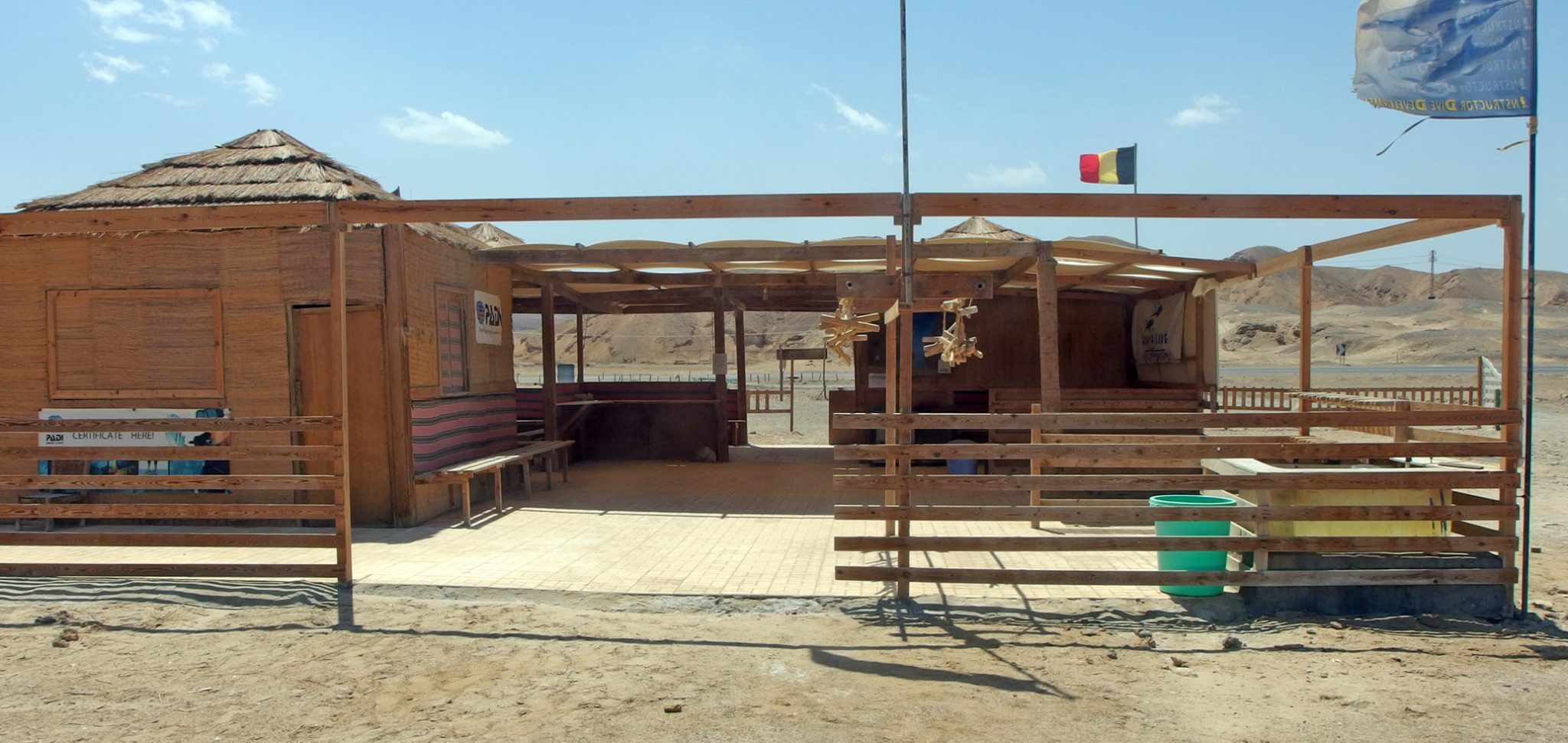
Join Richard Cullen from Deptherapy as we publish part 3 in his Blog about the charity’s recent expedition to Roots Red Sea, El Quseir, Egypt.
Today was planned to be our first day of open water diving in the Red Sea on the Roots’ House Reef. The Dive Centre and the House Reef are literally a 5-minute walk from the camp. If some beneficiaries are unable to make the walk then transport is provided.
All your kit, weights, cylinders etc are laid out ready for you to assemble your kit.
For those who use wheelchairs there is a paving stone pathway from the dive centre to the entry point for the reef. This, as with the provision of four fully accessible rooms in the resort, was built by Steve Rattle and his team to meet Deptherapy’s needs and to make the resort and reef accessible to all divers with disabilities.
A point here: in many Adaptive Teaching/Disabled Diving Manuals it is suggested that dive centres might wish to purchase a beach wheelchair. To justify the cost, you would need a considerable number of disabled clients who were unable to walk to the ocean entry point as they cost circa £3000. Using an individual’s wheelchair across sandy beaches is difficult and not a good idea. Many wheelchairs, such as Corey’s, cost thousands of pounds and getting sand/grit in the bearings can result in costly repairs. So, at Roots the staff have adapted and overcome the challenge, with the beach wheelbarrow. A foam pad is placed in the bottom and a towel draped over it. It is effective and allows divers like Corey to be taken to the beach, the wheelbarrow is pushed into shallow water and the diver either gets out of the transport himself or is lifted out by the Roots team. Everyone finds it a lot of fun!
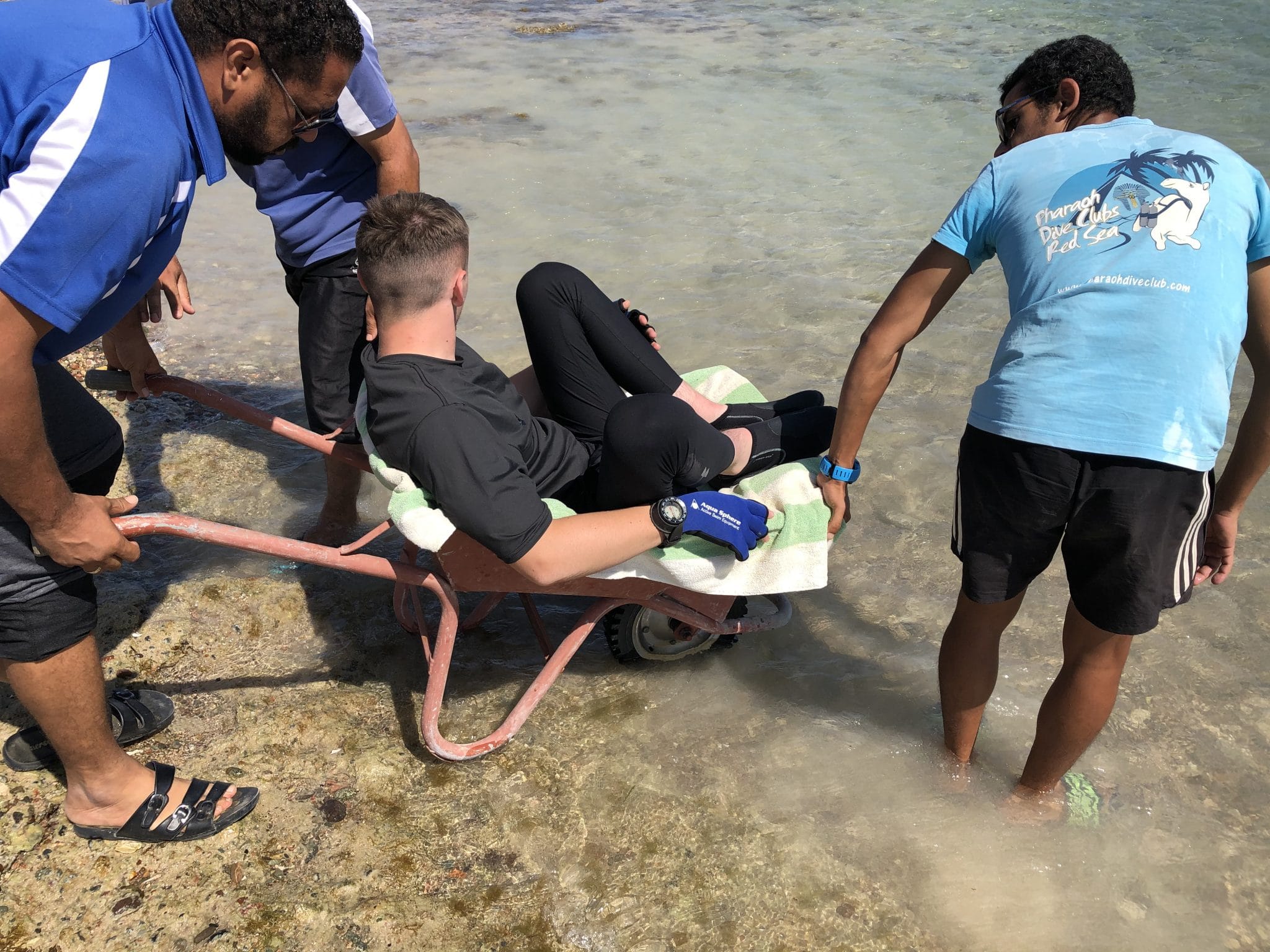
Your transport awaits!
Working with those with life-changing mental and/or physical challenges does require careful risk management, not just in the general risk models for groups of divers but individual risk assessments.
On the Deptherapy Education Professionals’ Course and adopted in all our programmes is the ‘Three Tick Model’. Before taking an individual diving, each of the following must be ticked off:
- Doctor certifies student fit to dive
- Student signs assumption of Liability and Risks
- Instructor is happy given the medical information to instruct the student.
As an Instructor, or as a dive centre owner you may wish to check that your insurance covers you for working with those with severe disabilities.
The instructor will meet with the student and complete a personalised risk assessment and will review whether there have been any changes in the student’s physical or mental health since their consultation with their doctor (in our case an AMED or Dive Referee). They will also check that the medication or its daily dosage has not changed.
In terms of those with severe challenges, an AMED or a Dive Referee may require full disclosure of medical records before making a decision. For Deptherapy we also reserve the right to refer a final decision to our two medical advisors, Dr Mark Downs or Dr Oli Firth, both of whom have considerable experience in dive medicine.
At the end of Day 1 the team were happy for Keiron to move forward; he is a strong, fit man and a capable diver who gives 100%. Corey is an amazing guy and was very quickly embraced as a member of the Deptherapy ‘family’. But sometimes there has to be tough love and in Deptherapy we are always very open with our beneficiaries. Some reach a level of certification beyond which they cannot progress. For Corey there was a serious discussion with the teaching team. He had completed his skills in the pool and met the standard required BUT none of us, especially me, had any confidence that he was the standard to be an Open Water Diver. A hard message to give to a young man who already had a certification card that said he was an Open Water Diver. He had either not been taught properly and certified without having met the required standards or he had forgotten all he had learned. My view is he is a bright young man and that the former reason must be correct.
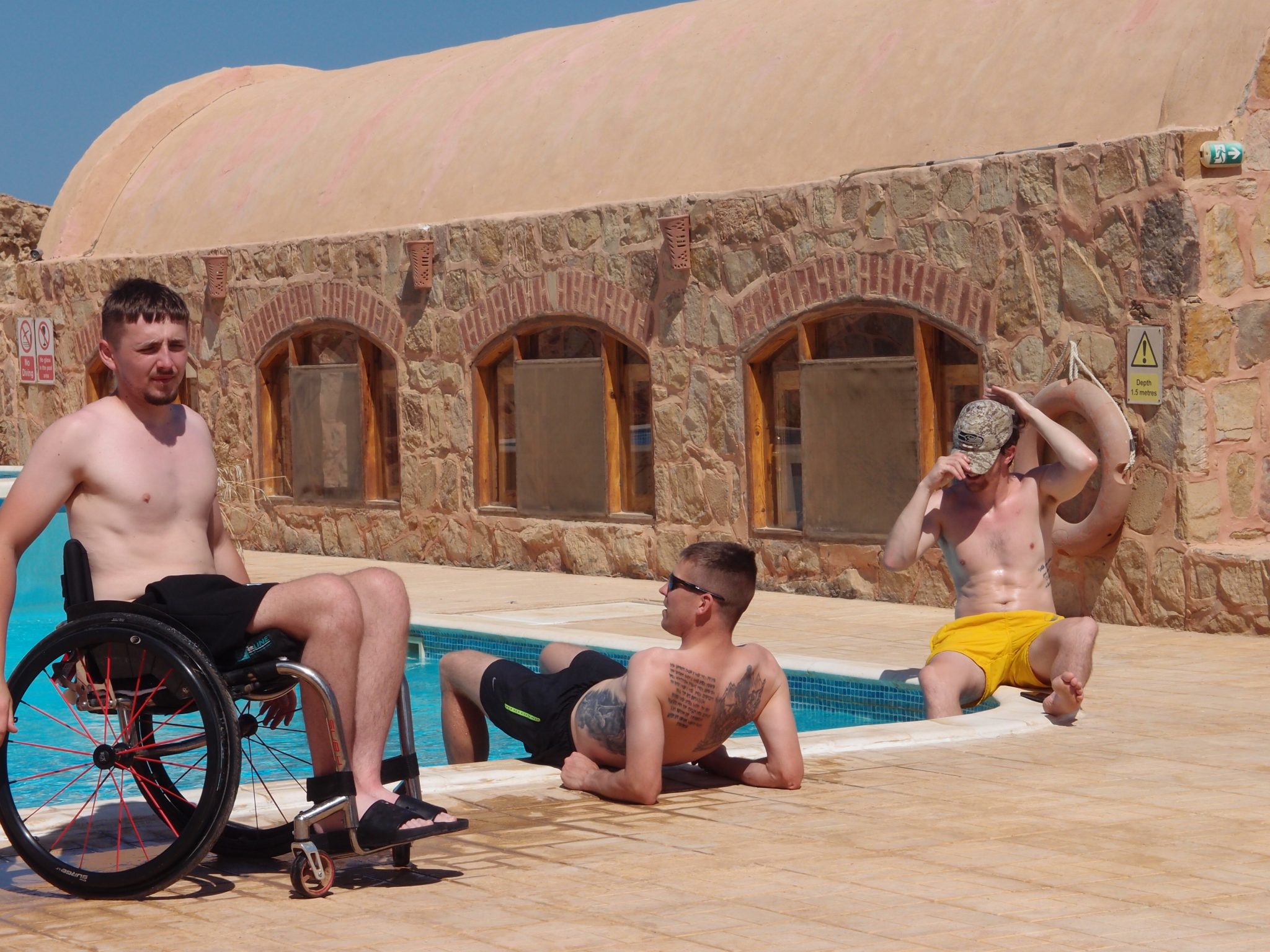
Corey, Keiron and Swars between confined dives by the Roots pool
The RAID definition of mastery:
‘When a student/learner can comfortably demonstrate proficiency and competence, when completing an entire motor skill including all the components of the skill in a manner that demonstrates minimal stress or hesitation.’
Each mainstream diving training agency defines mastery in similar terms. It was not Corey’s ability to do the skills, it was his ability to ‘dive’ that concerned us.
If weather conditions are right, the Roots House Reef meets the requirements for a ‘confined environment’ and on Day 3 it did.
Entry to the reef is through a channel and it goes from extremely shallow to 3-5 metres. There is a rope that allows a diver to control their descent and for use at the end of a dive if the current is running.
Most instructors will have seen nervous divers who say they have ear issues, not at a depth when there is any noticeable change in pressure, and those who continually fidget with their masks and other kit in an attempt to avoid descent. Corey displayed these traits.
We made the decision to move to the open water as it would give Corey more of an opportunity to get himself in a horizontal position rather than the upright position we saw in the pool. We struggled to get him down the line and into the sea. Eventually after much hard work we got there. He maintained the upright position and was using tiny arm and hand movements to propel himself forward. His buoyancy was poor. We decided to end this session and return to the pool.
A note here on trim and posture in the water for both amputees and those with paraplegia. When working with a leg amputee, especially a bilateral amputee, their balance at the surface is often poor, they tip forward, backwards and from side to side. This is often to do with weighting but also the fact that they do not have legs to weigh them down or to balance them. They also are often unaware of where their stumps (the term for the part of the limb remaining) are, and their stumps come up at right angles to their body. We have exercises to make amputees aware of this.
Those with paraplegia adopt a different stance, often they are upright in the water and their legs trail down, even when in trim their legs hang below the rest of their body. The team needs to ensure that the diver is properly weighted and that the horizontal position in the water in reinforced. Spatial awareness also needs to be created in the diver so that their legs and feet do not drag along the bottom or come into contact with coral. They need to become aware of where their legs and feet are in the water.
This was very hard for Corey and I was quite honest that he needed to improve considerably and learn to dive properly before I would allow him to move forward. He was gutted but up for the challenge, and what we saw over the next few days was a man committed to succeed!
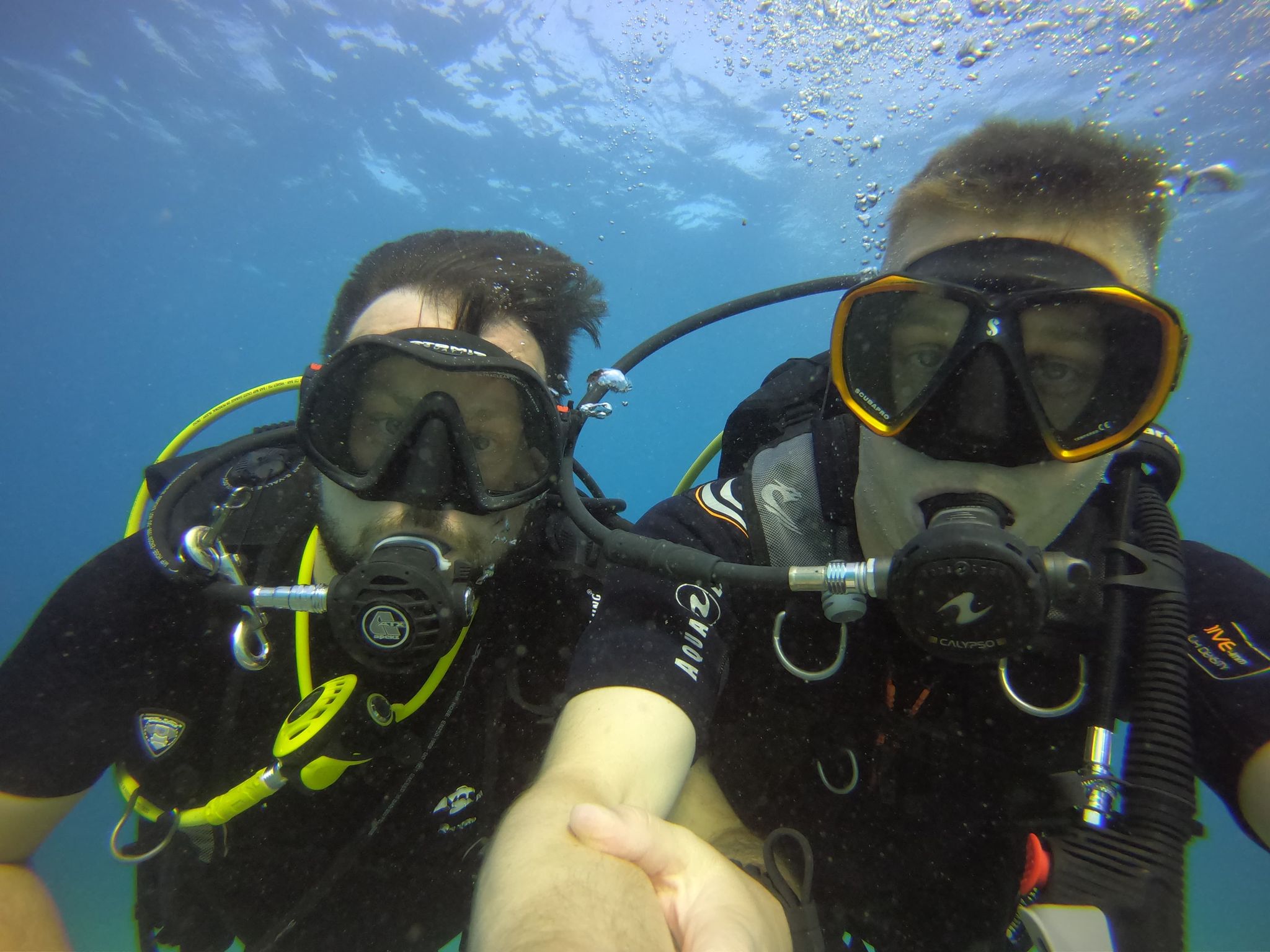
Michael and Keiron
So back to the pool with Oatsie and Michael. We went through all the skills for RAID OW20 twice and focussed on buoyancy, performing the skills neutrally buoyant, getting Corey in trim and teaching him how to swim underwater without the use of his legs. It is a pity that Chris Middleton, one of our divemasters and a bilateral amputee had to miss the expedition because of wisdom tooth surgery. Chris is a role model of how to swim underwater without the use of your legs.
Although I, all our Instructors and our DMs/TDMs can demonstrate how to swim underwater, not using your legs and using a modified free diving stroke, it is far better for someone with no legs or no use of their legs to demonstrate the skill.
By the end of the day Corey had progressed substantially and the Red Sea awaited him on Day 4.
Keiron had progressed well with his instructor Moudi and Swars and was getting added value with extra work on advanced buoyancy and SMB and DSMB deployment.
Tomorrow I will talk a little more about our TDMs; we expect very high standards from them. Michael and the two Toms have over 100 dives each. Michael dived with us in Chuuk Lagoon and both Toms have been on Red Sea liveaboards. We look for them to go beyond DM level and to progress to Instructor level. Swars had delayed the start of his DM programme, initially because of work and then COVID. He impressed, and here again, veterans have some advantages as they are used to briefings and therefore when you give them a model for a briefing they can quickly pull a high quality briefing together.
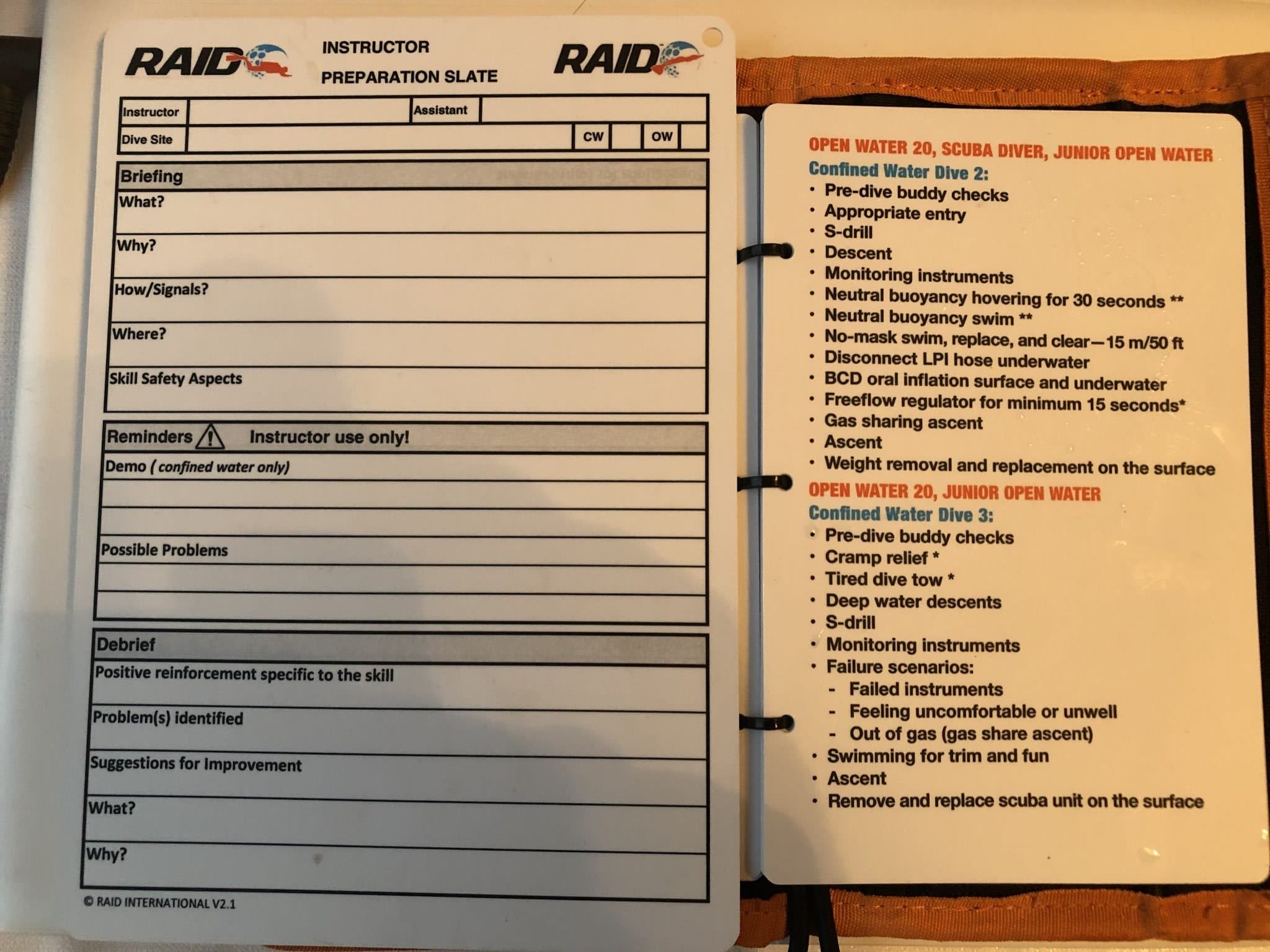
RAID Skill Briefing Checklist and OW20 slates
Throughout the week I found the RAID skills briefing slate excellent for the TDMs and the plastic skills slates are a great aide memoire for the whole team.
Find out more about the work of Deptherapy and Deptherapy Education at www.deptherapy.co.uk
Blogs
Jeff Goodman Launches Underwater Moviemaker Course with NovoScuba

Transform Your Dive Experiences into Cinematic Masterpieces
NovoScuba has partnered with acclaimed underwater filmmaker Jeff Goodman to introduce the Underwater Moviemaker Course—a revolutionary program designed to equip divers with the skills to capture the breathtaking beauty of the underwater world.
Whether you’re an aspiring filmmaker, an avid diver, or a photography enthusiast, this course offers the tools and expertise needed to create stunning underwater videos. From vibrant coral reefs to curious marine life, you’ll learn how to film, edit, and produce captivating underwater stories, all with expert guidance from a seasoned professional.
Jeff Goodman: A Legacy in Underwater Filmmaking
Jeff Goodman brings over 40 years of experience in underwater film production for television to this course. Reflecting on his career, Jeff said:
“Although technology has dramatically changed, the basics of underwater filming remain constant. This course covers crucial skills for producing great videos. Whether you’re creating professional broadcast films or high-quality hobby videos, the fundamental principles are the same.
A camera operator must master their equipment to capture those magical underwater moments effortlessly. But beyond technical know-how, underwater filmmaking is about having fun and enhancing your diving experiences. So, take your time, learn at your own pace, and enjoy this creative journey.”
About NovoScuba
Founded in 2023, NovoScuba is reshaping dive education with a comprehensive, digitally native platform. Offering cutting-edge training programs for divers at all levels, NovoScuba sets a new benchmark in the diving industry by combining innovation with accessibility.
With ISO-certified courses, a student subscription model, and multilingual support, NovoScuba ensures that dive education is inclusive and engaging. More than just a training provider, NovoScuba fosters a global community of divers committed to exploration, collaboration, and sustainability.
Join the NovoScuba Underwater Moviemaker Course Today!
Dive into the world of underwater filmmaking and start creating cinematic stories that inspire. Learn more about the course and enroll today at www.novoscuba.com/novoscuba-underwater-moviemaker-course.
EXCLUSIVE: Jeff Goodman interviews Mark Spiers, CEO of New Scuba Diving Training Agency NovoScuba
NovoScuba’s Game-Changing Approach for Dive Store Owners: WE PAY YOU!
The diving world thrives on passion and adventure, but for many dive store owners, the financial and operational challenges can be as deep as the ocean.
NovoScuba, an emerging force in the diving world, is on a mission to transform this landscape for the better. With a revolutionary approach to dive store and training agency partnerships, NovoScuba is setting new standards for how dive stores can thrive while keeping their focus on delivering exceptional diving experiences.

A New Paradigm: NovoScuba’s Bold Mission
NovoScuba’s mission is straightforward yet profound: to disrupt the traditional dynamics between dive store owners and training agencies. Traditionally, dive stores have been subjected to substantial fees charged by training agencies, for membership, materials and certifications. These costs have often placed a heavy financial burden on store owners, cutting into their profits and limiting their ability to offer competitive prices to customers.
NovoScuba flips the script by offering a model where dive stores earn money, instead of paying high fees. Dive stores receive commissions for every student they register, and their certification costs are covered. This new model not only boosts profitability but also ensures clients get top-quality training at unbeatable prices.
Financial Upsides: Earn From Student Registration
NovoScuba’s approach is simple yet revolutionary. Dive stores partnering with NovoScuba can earn commissions for every student they enroll.
Here’s how it works: For every student enrolled through NovoScuba, dive stores receive a commission. Each student enrolled will receive their e-learning materials and certification credit included in their subscription. This arrangement is a significant departure from the traditional model, where dive stores often struggle to manage high overhead costs related to training fees and certification expenses.

NovoScuba’s approach ensures that dive stores can focus on what they do best—providing top-notch diving experiences—without being bogged down by excessive financial burdens, and the need to carry large stocks of materials.
Quality Training at a Great Price
NovoScuba stands out by offering high-quality, ISO certified, training that doesn’t break the bank, in fact our students will pay less than with most competing agencies. Clients benefit from top-notch education and safety standards at competitive prices. Dive store owners can confidently promote NovoScuba’s programs, knowing they’re offering fantastic training at affordable rates. This balance of quality and affordability helps dive stores build a strong reputation and attract more customers.
Your Brand is Your Business: NovoScuba’s Commitment to Showcasing Your Identity
At NovoScuba, we understand that your brand is your most valuable asset, and we’re committed to putting it front and centre. Unlike agencies that charge high fees to promote their own brand, we believe in investing in yours. With NovoScuba, you won’t be paying to advertise someone else’s logo alone, — our focus is on showcasing your unique identity. Certifications prominently feature your brand, as well as the training agency, reinforcing your store’s image and brand every step of the way. We’re here to support and elevate your brand, ensuring that your investment directly benefits your business.
Affordable Membership: An Investment in Your Success
NovoScuba’s membership model is designed with dive store owners in mind. Membership fees are kept low and include annual Pro member fees for your team. Payment can be made monthly or annually in your local currency, avoiding the hassle of exchange rate fluctuations. NovoScuba promises no exchange rate changes without a six-month notice, ensuring financial stability and simplifying budgeting. With a membership lasting 12 months from date of joining, you’ll enjoy a full year of NovoScuba’s benefits and support.

Streamlined Operations: Simplifying Your Workload
Handling administrative tasks can be a challenge, but NovoScuba makes it easier. We’ve streamlined certification procedures and reduced paperwork to help dive stores operate more efficiently. Certification processing is quick and straightforward, allowing more focus on teaching and customer service. Our system minimises bureaucracy by storing necessary forms in student profiles, reducing paperwork and administrative delays.
Crossover Made Easy
For dive stores looking to transition to NovoScuba’s model, the crossover process is designed to be smooth and hassle-free. NovoScuba provides support to ensure that the transition is as seamless as possible, helping dive store owners integrate into the new system with minimal disruption. Experienced dive Pros don’t need to undergo extensive retraining. Our crossover is designed to familiarise Pros with NovoScuba’s user-friendly platform, standards and course structures, and not to waste time and expense re-training in water.
With just a few simple steps, you’ll be ready to offer top-notch training through NovoScuba.
Comprehensive Business Support and Training Included in Your Membership
NovoScuba goes beyond financial benefits by offering experienced support and training. This value added service includes:
- Business Training: Optimise your operations with guidance on marketing, customer service, and best practices.
- Marketing and Promotion: Access resources to attract new customers and boost your store’s visibility. Enjoy cross promotions with NovoScuba to gain increased exposure.
- Ongoing Support: NovoScuba’s commitment to its partners extends beyond initial training and setup. The company offers ongoing support to address any issues or questions that arise. This continuous support ensures that dive store owners have a reliable resource to turn to whenever they need assistance.

Embracing Digital Natives: Instant Evolution and Continuous Improvement
NovoScuba’s digital-native approach is a game-changer. Leveraging cutting-edge technology, we ensure our services evolve and improve swiftly. Dive stores benefit from instant updates, the latest features, enhancements, and effective solutions, keeping them ahead of the curve. This continuous improvement helps dive stores stay competitive and deliver exceptional services. Whether it’s a new course update, additional marketing resources, or improved e-learning functions, NovoScuba’s digital infrastructure ensures that dive stores are always equipped with the most current and effective solutions. This continuous evolution not only helps dive stores stay ahead in a competitive market but also ensures they consistently provide top-quality services to their clients.
Why Is NovoScuba Doing This? – Fair Profit Sharing for Greater Access and Growth
At NovoScuba, we’ve taken a bold step by paying commissions to stores rather than following the traditional model of training agencies charging high fees. Our mission is to make diving accessible to everyone and to foster a growing community of new divers and continued education. By redistributing profits more equitably between stores and training agencies, we aim to create a more supportive and collaborative environment within the industry. We believe this approach not only helps individual stores thrive but also stimulates overall growth and innovation in diving. Our commitment to fair profit sharing reflects our dedication to the long-term health and expansion of the diving community.

Everyone is getting a piece of the pie.
Getting Started: Join the NovoScuba Revolution
Ready to revolutionise your dive store experience? NovoScuba is here to support your journey toward reduced costs, increased profitability, and enhanced operational efficiency. Get in touch with our team to learn how NovoScuba can transform your business.
For more information, email info@novoscuba.com or visit www.novoscuba.academy.
Blogs
NovoScuba’s Game-Changing Approach for Dive Store Owners: WE PAY YOU!

 The diving world thrives on passion and adventure, but for many dive store owners, the financial and operational challenges can be as deep as the ocean.
The diving world thrives on passion and adventure, but for many dive store owners, the financial and operational challenges can be as deep as the ocean.
NovoScuba, an emerging force in the diving world, is on a mission to transform this landscape for the better. With a revolutionary approach to dive store and training agency partnerships, NovoScuba is setting new standards for how dive stores can thrive while keeping their focus on delivering exceptional diving experiences.

A New Paradigm: NovoScuba’s Bold Mission
NovoScuba’s mission is straightforward yet profound: to disrupt the traditional dynamics between dive store owners and training agencies. Traditionally, dive stores have been subjected to substantial fees charged by training agencies, for membership, materials and certifications. These costs have often placed a heavy financial burden on store owners, cutting into their profits and limiting their ability to offer competitive prices to customers.
NovoScuba flips the script by offering a model where dive stores earn money, instead of paying high fees. Dive stores receive commissions for every student they register, and their certification costs are covered. This new model not only boosts profitability but also ensures clients get top-quality training at unbeatable prices.
Financial Upsides: Earn From Student Registration
NovoScuba’s approach is simple yet revolutionary. Dive stores partnering with NovoScuba can earn commissions for every student they enroll.
Here’s how it works: For every student enrolled through NovoScuba, dive stores receive a commission. Each student enrolled will receive their e-learning materials and certification credit included in their subscription. This arrangement is a significant departure from the traditional model, where dive stores often struggle to manage high overhead costs related to training fees and certification expenses.

NovoScuba’s approach ensures that dive stores can focus on what they do best—providing top-notch diving experiences—without being bogged down by excessive financial burdens, and the need to carry large stocks of materials.
Quality Training at a Great Price
NovoScuba stands out by offering high-quality, ISO certified, training that doesn’t break the bank, in fact our students will pay less than with most competing agencies. Clients benefit from top-notch education and safety standards at competitive prices. Dive store owners can confidently promote NovoScuba’s programs, knowing they’re offering fantastic training at affordable rates. This balance of quality and affordability helps dive stores build a strong reputation and attract more customers.
Your Brand is Your Business: NovoScuba’s Commitment to Showcasing Your Identity
At NovoScuba, we understand that your brand is your most valuable asset, and we’re committed to putting it front and centre. Unlike agencies that charge high fees to promote their own brand, we believe in investing in yours. With NovoScuba, you won’t be paying to advertise someone else’s logo alone, — our focus is on showcasing your unique identity. Certifications prominently feature your brand, as well as the training agency, reinforcing your store’s image and brand every step of the way. We’re here to support and elevate your brand, ensuring that your investment directly benefits your business.
Affordable Membership: An Investment in Your Success
NovoScuba’s membership model is designed with dive store owners in mind. Membership fees are kept low and include annual Pro member fees for your team. Payment can be made monthly or annually in your local currency, avoiding the hassle of exchange rate fluctuations. NovoScuba promises no exchange rate changes without a six-month notice, ensuring financial stability and simplifying budgeting. With a membership lasting 12 months from date of joining, you’ll enjoy a full year of NovoScuba’s benefits and support.

Streamlined Operations: Simplifying Your Workload
Handling administrative tasks can be a challenge, but NovoScuba makes it easier. We’ve streamlined certification procedures and reduced paperwork to help dive stores operate more efficiently. Certification processing is quick and straightforward, allowing more focus on teaching and customer service. Our system minimises bureaucracy by storing necessary forms in student profiles, reducing paperwork and administrative delays.
Crossover Made Easy
For dive stores looking to transition to NovoScuba’s model, the crossover process is designed to be smooth and hassle-free. NovoScuba provides support to ensure that the transition is as seamless as possible, helping dive store owners integrate into the new system with minimal disruption. Experienced dive Pros don’t need to undergo extensive retraining. Our crossover is designed to familiarise Pros with NovoScuba’s user-friendly platform, standards and course structures, and not to waste time and expense re-training in water.
With just a few simple steps, you’ll be ready to offer top-notch training through NovoScuba.
Comprehensive Business Support and Training Included in Your Membership
NovoScuba goes beyond financial benefits by offering experienced support and training. This value added service includes:
- Business Training: Optimise your operations with guidance on marketing, customer service, and best practices.
- Marketing and Promotion: Access resources to attract new customers and boost your store’s visibility. Enjoy cross promotions with NovoScuba to gain increased exposure.
- Ongoing Support: NovoScuba’s commitment to its partners extends beyond initial training and setup. The company offers ongoing support to address any issues or questions that arise. This continuous support ensures that dive store owners have a reliable resource to turn to whenever they need assistance.
Embracing Digital Natives: Instant Evolution and Continuous Improvement
NovoScuba’s digital-native approach is a game-changer. Leveraging cutting-edge technology, we ensure our services evolve and improve swiftly. Dive stores benefit from instant updates, the latest features, enhancements, and effective solutions, keeping them ahead of the curve. This continuous improvement helps dive stores stay competitive and deliver exceptional services. Whether it’s a new course update, additional marketing resources, or improved e-learning functions, NovoScuba’s digital infrastructure ensures that dive stores are always equipped with the most current and effective solutions. This continuous evolution not only helps dive stores stay ahead in a competitive market but also ensures they consistently provide top-quality services to their clients.
Why Is NovoScuba Doing This? – Fair Profit Sharing for Greater Access and Growth
At NovoScuba, we’ve taken a bold step by paying commissions to stores rather than following the traditional model of training agencies charging high fees. Our mission is to make diving accessible to everyone and to foster a growing community of new divers and continued education. By redistributing profits more equitably between stores and training agencies, we aim to create a more supportive and collaborative environment within the industry. We believe this approach not only helps individual stores thrive but also stimulates overall growth and innovation in diving. Our commitment to fair profit sharing reflects our dedication to the long-term health and expansion of the diving community.

Everyone is getting a piece of the pie.
Getting Started: Join the NovoScuba Revolution
Ready to revolutionise your dive store experience? NovoScuba is here to support your journey toward reduced costs, increased profitability, and enhanced operational efficiency. Get in touch with our team to learn how NovoScuba can transform your business.
For more information, email info@novoscuba.com or visit www.novoscuba.academy.
-

 News2 months ago
News2 months agoIconic SS United States to become the World’s Largest Artificial Reef
-

 News3 months ago
News3 months agoBook Review – 52 Assignments: Underwater Photography
-

 Gear News3 months ago
Gear News3 months agoDYNAMICNORD – New German diving brand enters the British market
-

 News3 months ago
News3 months agoExploring Cenote El Pit: A Diver’s Dream
-

 Gear News3 months ago
Gear News3 months agoTry BARE drysuits (and maybe even win one!) this Friday with Sea & Sea at North West Dive Fest
-

 Marine Life & Conservation3 months ago
Marine Life & Conservation3 months agoBook Review: Coral Triangle Cameos
-

 Blogs2 months ago
Blogs2 months agoDive the Egyptian Red Sea this Autumn with Regaldive
-

 News3 months ago
News3 months ago2024 Ocean Art Underwater Photo Competition Announced
















